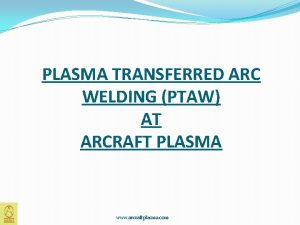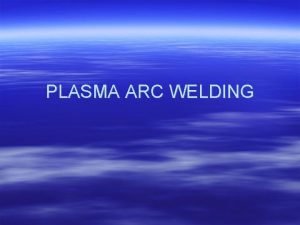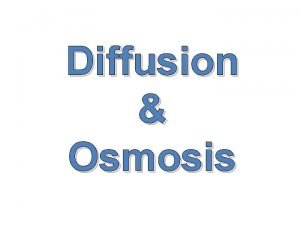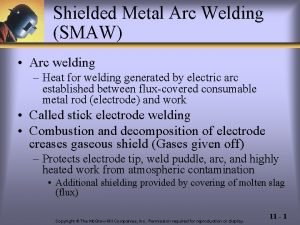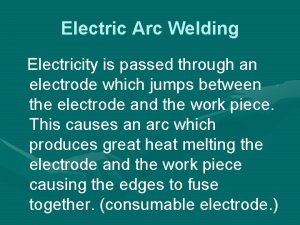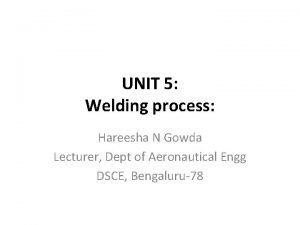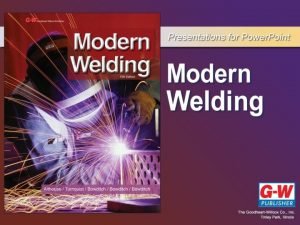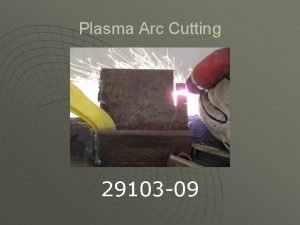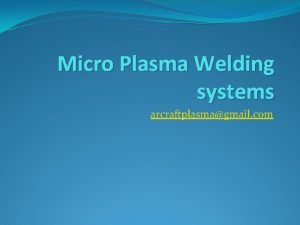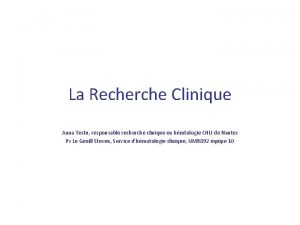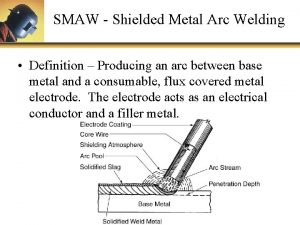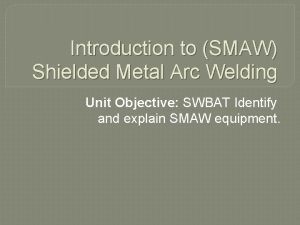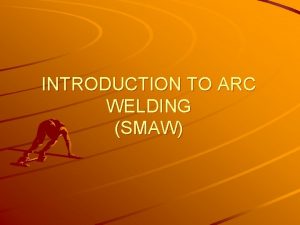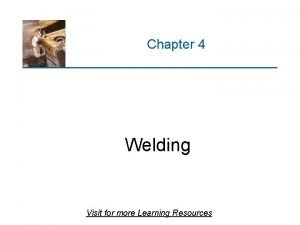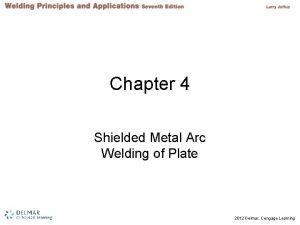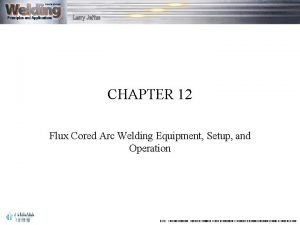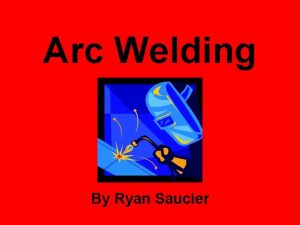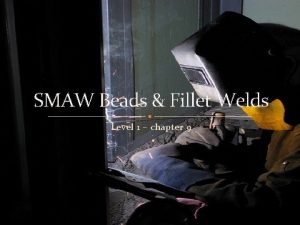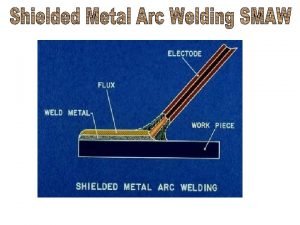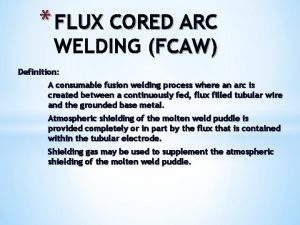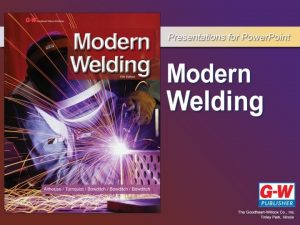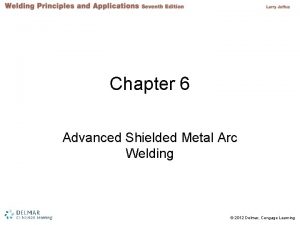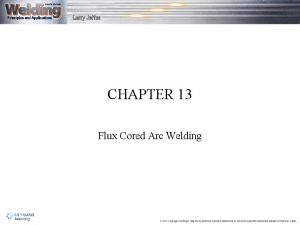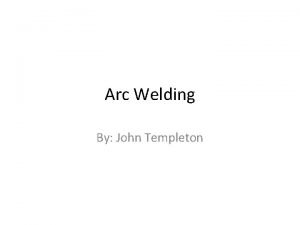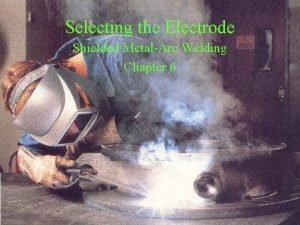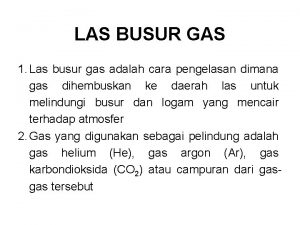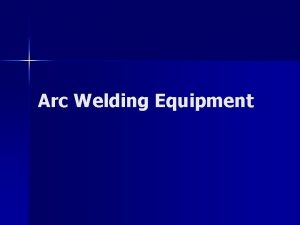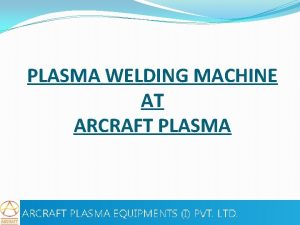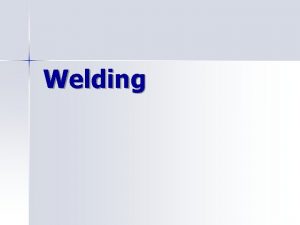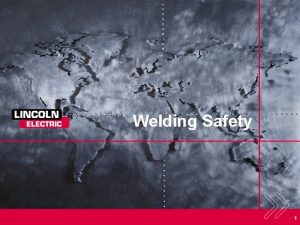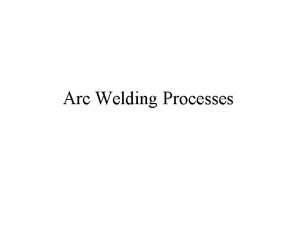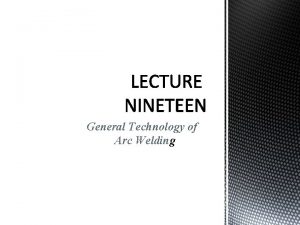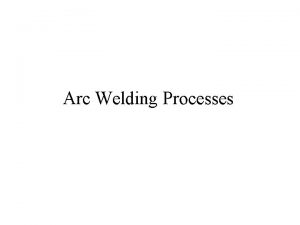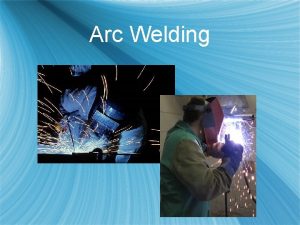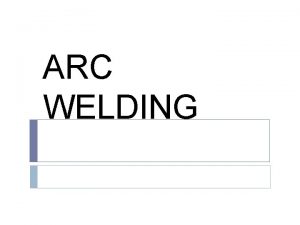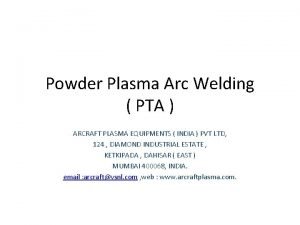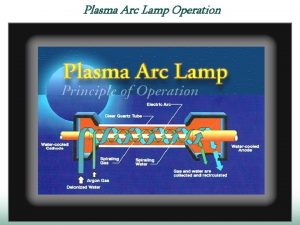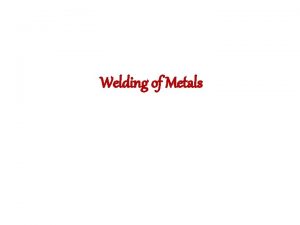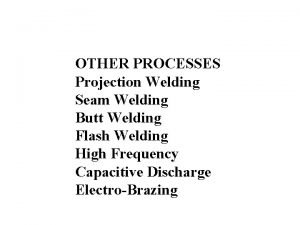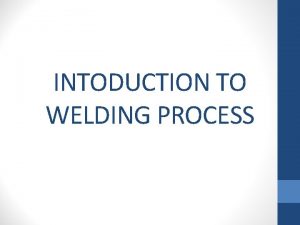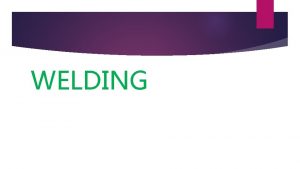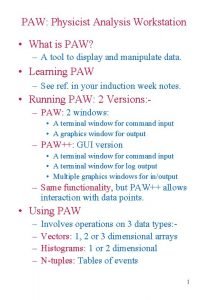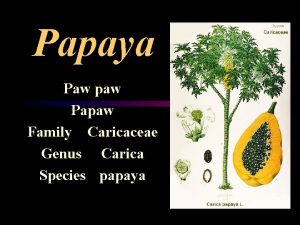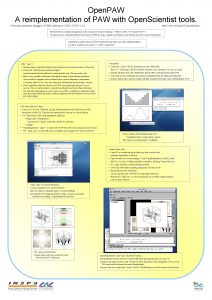PLASMA ARC WELDING PAW Principle of operation Principle






























- Slides: 30

PLASMA ARC WELDING

PAW - Principle of operation

Principle of operation

Principle of operation TIG vs. Plasma welding

TIG vs. Plasma welding comparison Plasma welding TIG welding • TIG arc is not constricted relative wide heat pattern on the workpiece • electrode is recessed arc is collimated and focused by the constricting nozzle • arc is conical heated area varies with electrode-to-work distance • electrode is recessed impossible for the electrode to touch the workpiece • electrode extends beyond the end of gas nozzle possible weld contamination • arc is essentially cylindrical very little change in the heated area

Arc constriction Factors affecting intensity of plasma • plasma (electrical) current: higher for cutting, lower for welding • orifice diameter and shape: smaller for cutting, larger for welding • type of orifice gas • orifice gas flow rate: higher for cutting, lower for welding • distance to workpiece

Plasma arc modes generally used for welding work is part of electrical circuit heat is obtained from anode spot and from plasma jet greater energy transfer to the work

Plasma arc modes used for cutting and joining nonconductive workpiece is not in the arc circuit heat is obtained from plasma jet only low energy concentration

Plasma process techniques Microplasma very low welding currents (0, 1 -15 Amps) very stable needle-like stiff arc minimises arc wander and distortions for welding thin materials (down to 0, 1 mm thick), wire and mesh sections Medium current plasma higher welding currents (15 -200 Amps) similar to TIG but arc is stiffer deeper penetration more control on arc penetration

Plasma process techniques Microplasma and medium current plasma advantages energy concentration is greater higher welding speed energy concentration is greater lower current is needed to produce a given weld less distortions improved arc stability arc column has greater directional stability narrow bead less distortions less need for fixturing variations in torch stand-off distance have little effect on bead width or heat concentration positional weld is much easy tungsten electrode is recessed no tungsten

Plasma process techniques Microplasma and medium current plasma limitations narrow constricted arc little tolerance for joint misalignment manual torches are heavy and bulky difficult to manipulate for consistent quality, constricting nozzle must be well maintained

Plasma process technique

Plasma process techniques Keyhole plasma welding currents over 100 Amps for welding thick materials (up to 10 mm)

Plasma process techniques Keyhole plasma welding advantages plasma stream helps remove gases and impurities narrow fusion zone reduces transverse residual stresses and distortion a square butt joint configuration is generally used reduced joint preparation single pass weld reduced weld time

Plasma process techniques MMA MAG TIG PAW

Plasma process techniques Keyhole plasma welding limitations more process variables and narrow operating windows fit-up is critical increased operator skill, particularly on thicker materials high accuracy for positioning except for aluminium alloys, keyhole welding is restricted to downhand position for consistent operation, plasma torch must be well maintained

Plasma welding equipment

Plasma welding equipment DCEN for most welding applications AC (usually square wave) for aluminium and magnesium alloys pulsed current for better profile and weld bead shape drooping characteristic power source “pilot” arc is initiated using HF pilot arc ensures reliable arc starting and it obviates the need for HF high OCV required (50 - 200 V) additional interlocks to detect low gas flow, loss of coolant, etc

Plasma welding torch Torch body Tungsten electrode Water cooled copper nozzle Shielding gas cup

Plasma welding torch operates at very high temperatures cooling is mandatory heavy and bulky limitations on hand held torches alignment, setting, concentricity of tungsten electrode needs precision

Gases for plasma welding • Argon for carbon steel, titanium, zirconium, etc • Hydrogen increase heat Argon + (5 -15%) Hydrogen for stainless steel, Nickel alloys, Copper alloys • Argon + Helium mixtures (min 40%) give a hotter arc but reduces torch life • Shielding gases as for TIG • shielding gas flow rate 10 -30 l/min • back purge as for TIG (also for keyhole)

PAW advantages improved arc stability at very low currents greater energy concentration higher welding speed narrower beads less distortion (as much as 50%) tungsten electrode is recessed inside the torch no danger of tungsten inclusions increased torch stand-off distance makes the weld pool much easy to control arc column is cylindrical easier out-of-position welding very deep penetration (keyhole) reduced weld time

PAW disadvantages narrow constricted arc little tolerance for joint misalignment manual plasma torches are heavier than TIG torches difficult to manipulate more complex equipment than TIG expensive except Al alloys, keyhole plasma is restricted to the flat position torch must be well maintained for consistent operation costly

Plasma cutting • no need to promote oxidation no preheat • works by melting and blowing and/or vaporisation • gases: air, Ar, N 2, O 2, mix of Ar + H 2, N 2 + H 2 • air plasma promotes oxidation increased speed but special electrodes need • shielding gas - optional • applications: stainless steels, aluminium and thin sheet carbon steel

Plasma cutting

Plasma cutting features Advantages Limitations • Can be used with a wide range of materials • Limited to 50 mm (air plasma) thick plate • High quality cut edges can be achieved • High noise especially when cutting thick sections in air • Narrow HAZ formed • Low gas consumable (air) costs • Ideal for thin sheet and stack cutting • Low fume (underwater) process • High fume generation when cutting in air • Protection required from the arc glare • High equipment and consumable costs

Plasma cutting quality • tapered cut up to 6° • rounded top edge • gas swirl can reduce taper up to 2° • very smooth surface finish except aluminium and thick materials • dross is minimal • kerf width wider than oxy fuel cutting • HAZ width inverse to cutting speed • no time for chromium carbides to form • 2000 and 7000 series aluminium alloys are crack sensitive at surface

Plasma cutting equipment

Plasma cutting equipment • manual cutting - limited to drag along • machine cutting - stand off close tolerances • motion - CNC • power source - cc dropping characteristic • need high OCV • problems with bevels and multiheads • easy to perform interrupted cutting

Plasma gouging • lower arc stream velocity • gouge is bright and clean • virtually no post cleaning required • used mainly on stainless steels and non-ferrous materials
 Plasma transferred arc welding
Plasma transferred arc welding Micro plasma welder
Micro plasma welder Give an example of diffusion that is not a candle
Give an example of diffusion that is not a candle Principle of smaw
Principle of smaw Principle of electric arc welding
Principle of electric arc welding Advantages of welding
Advantages of welding Chapter 10 plasma arc cutting
Chapter 10 plasma arc cutting The simplest plasma arc cutting units use filtered
The simplest plasma arc cutting units use filtered Micro plasma welding
Micro plasma welding Arc promoteur vs arc investigateur
Arc promoteur vs arc investigateur Minor arc and major arc
Minor arc and major arc Minor aec
Minor aec Arc emu88 com arc info 09 100009 html
Arc emu88 com arc info 09 100009 html The shielded metal arc welding machines voltage output
The shielded metal arc welding machines voltage output Smaw definition
Smaw definition Tools of smaw
Tools of smaw Arc welding introduction
Arc welding introduction Tig (tungsten inert gas)
Tig (tungsten inert gas) Chapter 4 shielded metal arc welding of plate
Chapter 4 shielded metal arc welding of plate Globular transfer welding
Globular transfer welding History of arc welding
History of arc welding Stringer or weave bead
Stringer or weave bead Smaw electrode classification
Smaw electrode classification Fcaw meaning in welding
Fcaw meaning in welding Lesson 6b shielded metal arc welding fundamentals
Lesson 6b shielded metal arc welding fundamentals Chapter 6 advanced shielded metal arc welding
Chapter 6 advanced shielded metal arc welding Fca welding practice plates thicker than 1/2 inch ____.
Fca welding practice plates thicker than 1/2 inch ____. Objectives of welding
Objectives of welding Fill freeze electrode examples
Fill freeze electrode examples Las busur rendam
Las busur rendam Joan of arc map
Joan of arc map
